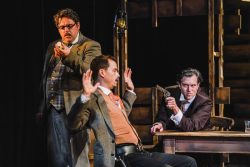 THE punchline of the old joke about the local yokels’ reply to a passing motorist asking for directions: “I wouldn’t start from here in the first place”, in some ways fits this adaptation of Sir Arthur Conan Doyle’s story. The story takes us back and forth from late 19th century Pennsylvanian coal fields and the battle between the Irish American secret society The Molly Maguires and the Pinkerton Detective agency, and murder in an English country house. It is a complex one, not easy to tell, even in two and a half hours.
THE punchline of the old joke about the local yokels’ reply to a passing motorist asking for directions: “I wouldn’t start from here in the first place”, in some ways fits this adaptation of Sir Arthur Conan Doyle’s story. The story takes us back and forth from late 19th century Pennsylvanian coal fields and the battle between the Irish American secret society The Molly Maguires and the Pinkerton Detective agency, and murder in an English country house. It is a complex one, not easy to tell, even in two and a half hours.
In the adaption by Nick Lane, who also directs the production, there are 20 different characters. The decision to create them via just five actors not only places a heavy burden on the cast, which they readily accept, but also on the imagination and concentration of the audience which, judging from interval and after final curtain call remarks, they were not always able to fully accept.
The adaptation also relied heavily on quite a few lengthy discourses on his thought processes from Bobby Bradley as Sherlock Holmes, which despite being delivered absolutely in character, were not always attention grabbing, as well asinjections of narration from Joseph Derrington’s expertly crafted Dr Watson.
The swift set move of time and place, performed on the run by the cast, kept the action moving apace, but the combined set and lighting designs of Victoria Spearing and Oliver Welsh did not readily create a distinctive atmosphere that told us the action had moved to or from England and America.
And with due respect to a talented cast, who switched characters with dexterity, it took the audience a little time to acclimatise themselves visually and dramatically to Bobby Bradley becoming a violent member of the Molly Maguires, Joseph Derrington, the society’s cringing accountant, and Blake Kubena, Gavin Molloy, and Alice Osmanski, hoovering up the remaining 15 characters.
The challenges facing Messrs Kubena, Molloy and Osmanski in creating their many characters pale into insignificance when you look at the actors Bobby Bradley and Joseph Derrington have to follow.
There have been dozens of adaptations of Conan Doyle’s Sherlock Holmes’stories with three outstanding actors who have created the character on stage and screen, each leaving an indelible mark. American William Gillette not only portrayed Holmes for many years on stage, but also in the first truly successful screen version in 1916. It was he who popularised the image of the deerstalker hat and curled pipe. Basil Rathbone with Nigel Bruce’s wonderful bumbling Dr Watson together survived a series of poor Hollywood interpretations, and Jeremy Brett, with first David Burke and later Edward Hardwicke as Watson, gave a definitive portrayal in the ten-year TV series.
This adaptation does not isolate Holmes enough to make it easy to create the solitary, aloof figure with just a hint of vulnerability, but he captured the cool air of a man so engrossed in his own thoughts that he does not realise how he is pushing friends away. The image was greatly enhanced by Joseph Derrington’s thoughtful portrait of Dr Watson. The sincerity on view when he thought he was being cast aside by Holmes made him a very likeable real person.
It is not the best known or most popular of the Sherlock Holmes stories so Blackeyed Theatre took a bit of a flyer choosing to adapt The Valley of Fear, but it gives audiences a rare opportunity to see this Conan Doyle story on stage.
GRP